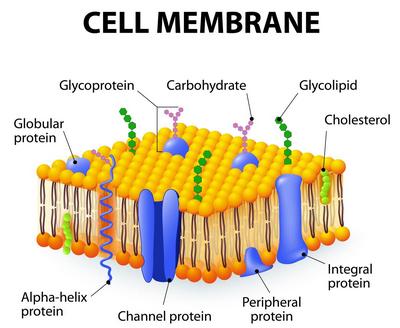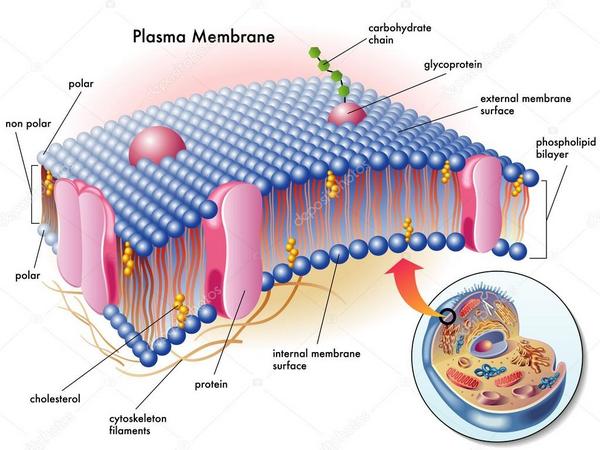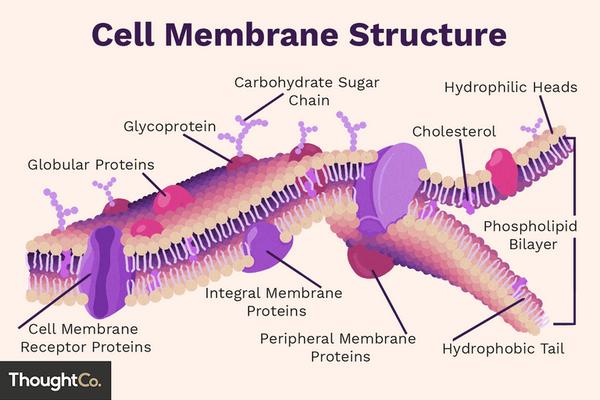Cell Membrane

Content:
It’s no secret that all living beings on our planet are made up of cells, these countless “atoms” of organic matter. The cells, in turn, are surrounded by a special protective membrane, that plays a very important role in the life of the cell. Functions of the cell membrane are not limited only to the protection of the cell, but constitute the most complex mechanism involved in the reproduction, nutrition, and regeneration of the cell.
Definition
What is a membrane? The word “membrane” means “envelope” in Latin. Although the membrane is not just the kind of envelope in which the cell is wrapped, it is a combination of two envelopes interconnected and having different properties. In fact, the cell membrane is a three-layer lipoprotein (fat-protein) membrane that separates each cell from neighboring cells and the environment and carries out a controlled exchange between cells and the environment.
The importance of the membrane is enormous, because it not only separates one cell from another, but ensures the interaction of the cell, both with other cells and with the environment.

Functions
Now let’s look at what functions the cell membrane performs:
- The barrier function of the cell membrane – the membrane as a real border guard, stands guard over the borders of the cell, stopping harmful or unsuitable molecules. This is the main function of the cell membrane.
- The transport function of the cell membrane – the membrane is not only a border guard at the cell gate but also a kind of customs checkpoint. Nutrients are constantly exchanged with other cells and the environment thru the cell membrane.
- Matrix function – it is the cell membrane that determines the location of cell organelles, regulates the interaction between them.
- The mechanical function is responsible for restricting one cell from another and for correctly connecting the cells with each other and for forming them into a homogeneous tissue.
- The protective function of the cell membrane is the basis for building a protective shield of the cell. Solid wood, dense skin, the protective shell of a tortoise can be examples of the protective function of the cell membrane.
- Energy function – photosynthesis and cellular respiration would not be possible without the participation of the protein contained in the cell membrane. An important cellular energy exchange takes place through protein channels.
- Receptor function – and again we return to the membrane proteins. In addition to the actual energy exchange, they have another very important function – they serve as receptors of the cell membrane, thanks to which the cell receives a signal from hormones and neurotransmitters. All this is necessary for the normal course of hormonal processes and the conduct of a nerve impulse.
- The enzymatic function is another important function performed by some proteins in the cell. For example, thanks to this function, digestive enzymes are synthesized in the intestinal epithelium.

Structure
What is the structure of the cell membrane? The cell membrane is made up of lipids (molecules made up of a phosphate group head and two fatty acid tails). There are three classes of lipids in cell membrane:
- phospholipids (a combination of fat and phosphorus),
- glycolipids (a combination of fats and carbohydrates),
- cholesterol.
Phospholipids and glycolipids, in turn, consist of a hydrophilic head, into which two long hydrophobic tails depart. Cholesterol occupies the space between these tails, preventing them from bending. All this in some cases makes the membrane of certain cells very rigid. In addition to all this, cholesterol molecules order the structure of the cell membrane.
The most important part of the structure of the cell membrane is protein, more precisely, different proteins that play various important roles. Despite the diversity of proteins contained in the membrane, there is something that unites them – annular lipids which are located around all membrane proteins. Annular lipids are specially structured fats that serve as a kind of protective membrane for proteins, without which they would not work.
The structure of the cell membrane has three layers: the base of the cell membrane is a homogeneous liquid bilipid layer. Proteins cover it on both sides like a mosaic. It is proteins (in addition to the functions described above) also play the role of peculiar channels through which substances that cannot penetrate through the liquid layer of the membrane pass through the membrane. In other words, proteins provide permeability of cell membranes.
If you’ll look at the cell membrane through a microscope, you’ll see a layer of lipids formed by small spherical molecules along which proteins float like a sea.
References and Further Reading
- Kimball’s Biology pages Archived 2009-01-25 at the Wayback Machine, Cell Membranes.
- Singleton P (1999). Bacteria in Biology, Biotechnology and Medicine (5th ed.). New York: Wiley. ISBN 978-0-471-98880-9.
- Jump up to: a b c d e f g h Alberts B, Johnson A, Lewis J, et al. (2002). Molecular Biology of the Cell (4th ed.). New York: Garland Science. ISBN 978-0-8153-3218-3. Archived from the original on 2017-12-20.
- Budin, Itay; Devaraj, Neal K. (December 29, 2011). “Membrane Assembly Driven by a Biomimetic Coupling Reaction”. Journal of the American Chemical Society. 134 (2): 751–753. doi:10.1021/ja2076873. PMC 3262119. PMID 22239722.
- Staff (January 25, 2012). “Chemists Synthesize Artificial Cell Membrane”. ScienceDaily. Archived from the original on January 29, 2012. Retrieved February 18, 2012.

Author: Pavlo Chaika, Editor-in-Chief of the journal Poznavayka
When writing this article, I tried to make it as interesting and useful as possible. I would be grateful for any feedback and constructive criticism in the form of comments to the article. You can also write your wish/question/suggestion to my mail pavelchaika1983@gmail.com or to Facebook.

